How I Built India’s Largest Digital Marketing Group on Facebook

A few years back I started a group on Facebook called Learn Digital Marketing. It started with a few members and grew to a few hundred in the first few weeks. Today it has 56,000+ members and is the largest digital marketing group in India.

The initial set of members were from my network. But instead of waiting for people to discover and join the group, I followed a few key promotional strategies to increase the membership.
In this article, I want to share some of the strategies that I used to grow this group. But before we dive into the promotional strategies, let’s look at the benefits of having a group on Facebook.
Why Facebook Groups?
A Facebook group is an excellent content asset for business. Though you don’t have complete control over it, the benefits outweigh the downsides.
This Digital Marketing Facebook group is one of the top assets of my business apart from my blog and the email list. My primary revenue channel is selling digital marketing courses to my audience. On this group, my audience and potential customers hang out.
I get feedback for my products, get new product ideas and understand my audience better. For example, look at this post where I am asking for new ideas for blog posts. I’ve got plenty of comments that helps me get new blog topic ideas.
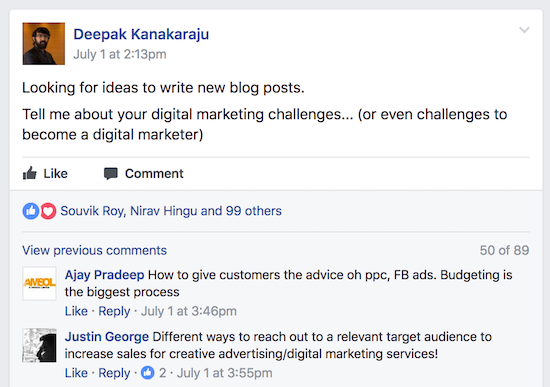
It is also a platform where I can promote my products and blog posts. If I share a blog post on this group, the post gets at least a 1,000 clicks. That’s worth $100 to me.
A group with 50,000 engaged members is 10x valuable that a Facebook page with 50,000 likes because the engagement on a group is a lot higher.
The engagement is greater because the group members create most of the content, help out each other and contribute. It is not a one-way communication platform from a brand, unlike a Facebook Page. I’ve tried asking the same questions on my Facebook Page and the engagement is never as great as the one on the group.
Facebook groups also get a higher engagement than stand-alone forum platforms. That’s because in other platforms, there is no curated delivery mechanism for content, and it results in information overload. Facebook groups perform better because Facebook curates the posts for its users and delivers it on the main news feed. The algorithm decides what posts to show and what not to show based on the user’s past behaviour and interests.
This is the same algorithm which decides whether to show you your friend’s update or not. Over time this algorithm has become very intelligent and shows posts to people only when the algorithm thinks that it would be interesting for them.
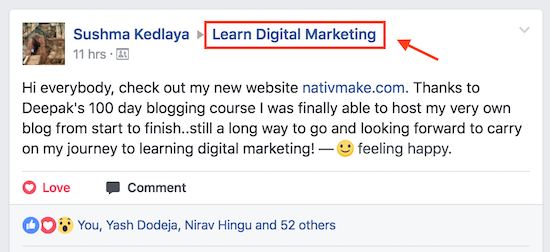
The above screenshot is from my newsfeed and not a screenshot from the group. Group members need not keep visiting the group to find content that would be interesting to them. Once they find some interesting content on their news feed, they will come to the group and engage in it.
Facebook takes care of promoting the group posts to them in a way that is not intrusive to them. The algorithm makes sure that only interesting and useful posts are delivered. This is part of Facebook’s strategy to keep users hooked to the platform!
Facebook also promotes posts across all the groups as you can see here:

Now that we have had a look at why Facebook groups are awesome let’s have a look at the strategies that I used to grow my group.
1. Promoting the Group Link Outside Facebook
A significant chunk of the members joined this group through my email list. People subscribe to my free digital marketing course from www.LearnDigitalMarketing.com or my blog.
I send them one free video lesson on digital marketing every day. In the first few emails, I link to the Facebook Group and ask them to join.
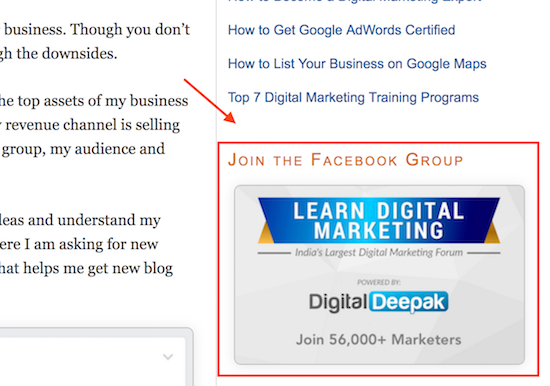
I’ve also added a widget on my blog to join the group directly. You can see the widget on the sidebar if you are viewing this from desktop. Direct linking from outside Facebook gets me a few hundred new members every day to the group.
2. Promoting Internal Posts on the Group Outside Facebook
Every internal post on the group will have its permalink. I can deep link to this post from my email list or blog posts. To get the permalink, click on the timestamp in the Facebook post.
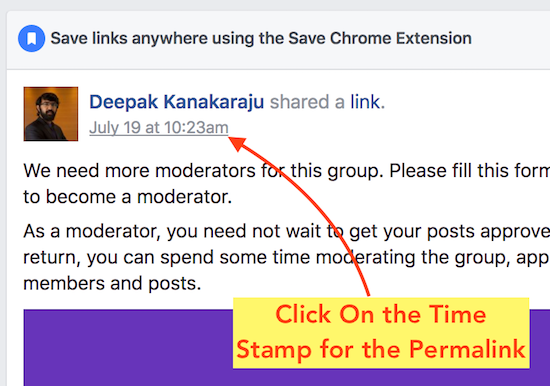
I treat the group as my content management system. Instead of publishing something on my blog, I share it on the group and promote the link to it on my email list or the blog.
When I promote internal posts, people who are not members of your group will want to join the group to see the content. Existing members will continue to have real engagement.
The only problem with content published on a Facebook group is that it will get buried over time and it’s hard to fetch old posts. In that case, it is best to save the permalinks of good group posts on a separate spreadsheet with some information about the post. Facebook also has an internal save post feature which can be used to bookmark the good posts.
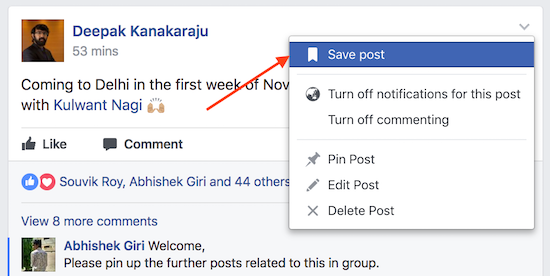
3. Promote the Group Link from Facebook Page & Boosting it
There is no option for promoting a group with Facebook ads. However, I share the link to the group on my Facebook page and then Boost the post. The post will have a link to the group, and there will be a Join button right on the post. People can join the group with 1-click.
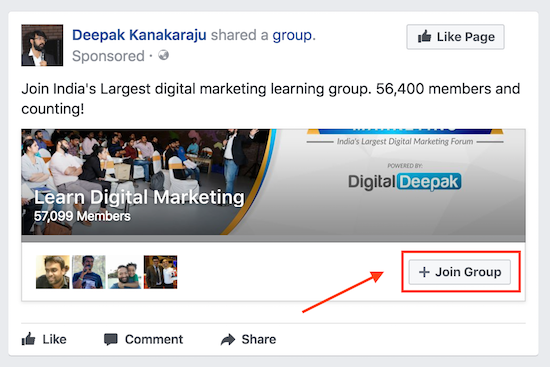
I have a budget of $5 per day for promoting this post. The paid promotion gives me a steady inflow of members. This is one group promotion secret I’ve shared until now!
It is not recommended to advertise heavily for a short period because if too many people join too soon, the group will have a lot of moderation work and also members will not get to know each other. Low-quality posts and replies will reduce the engagement of the group.
Keeping up the Quality and Engagement of the Group
The above three strategies helped me grow the group. Many Facebook groups are huge but do not get engagement. It is a constant effort to maintain the quality & engagement of posts in the group.
To keep up the quality and engagement on the group, I do not self-promote a lot. I share useful content from around the web. I ask questions, share small posts within the group, publish polls, upload photos, videos, files and so on.
I encourage other members to contribute and answer people’s questions. Some volunteer to do it. I conduct competitions within the group. I keep the engagement high with interactions. I spend at least one hour on the group every day.
I also take efforts to delete posts and comments that are not of high quality. I do not allow other members to self-promote. I ban members who violate the group rules that I’ve set. I have group rules that I have published on the group. I am also planning to release a short video about the rules and pin it on the group.
All the above mentioned strategies helps me keep up the quality and engagement on the group.
Managing the Group as it Grows
The admin cannot manage the group beyond 5,000 members. Facebook allows us to have moderators for the group. An admin of the group can make other members as moderators.

Moderators can approve members, delete members, approve posts if posts need approval by default, delete posts and comments. They cannot make others as moderators.
I have a combination of volunteers and a full-time staff to moderate the group. We’ve also made a separate chat group on FB for all the moderators. Here we discuss what types of posts can be approved and what type of posts shouldn’t be encouraged.
Final Words
Managing a group is no simple task, but if managed well, it can become one of the best assets of your business.
I’ve shared all my experience and learning in this post. I hope this post gave you enough insights on how to grow and maintain a Facebook Group.
Have questions? Leave a comment below.